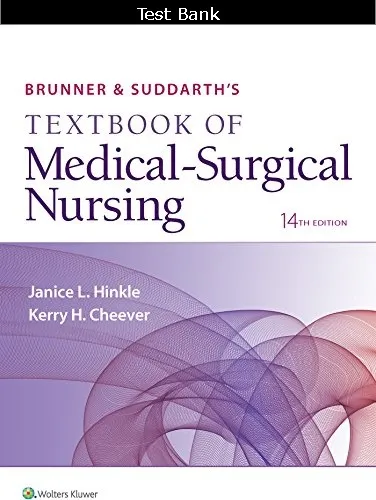Brunner & Suddarth Textbook of Medical-Surgical Nursing 14th Edition Hinkle, Cheever Test Bank
$55.00 Original price was: $55.00.$19.00Current price is: $19.00.
Digital item No Waiting Time Instant Download
Chapters: 68
Format: PDF
ISBN-13: 978-1496347992
ISBN-10: 1496347994
Publisher: LWW
Authors: Janice L Hinkle, Kerry H. Cheever
Description
Brunner & Suddarth Textbook of Medical-Surgical Nursing 14th Edition Hinkle, Cheever Test Bank
Table of Contents
Chapter 1
The public health nurse is presenting a health promotion class to a group of new mothers.
1. How should the nurse best define health?
A) Health is being disease free.
B) Health is having fulfillment in all domains of life.
C) Health is having psychological and physiological harmony.
D) Health is being connected in body, mind, and spirit.
Ans: D
Feedback:
The World Health Organization (WHO) defines health in the preamble to its constitution
as a “state of complete physical, mental, and social well-being and not merely the
absence of disease and infirmity.” The other answers are incorrect because they are not
congruent with the WHO definition of health.
2.
A nurse is speaking to a group of prospective nursing students about what it is like to be a
nurse. What is one characteristic the nurse would cite as necessary to possess to be an
effective nurse?
A) Sensitivity to cultural differences
B) Team-focused approach to problem-solving
C) Strict adherence to routine
D) Ability to face criticism
Ans: A
To promote an effective nurse-patient relationship and positive outcomes of care, nursing
care must be culturally competent, appropriate, and sensitive to cultural differences.
Team-focused nursing and strict adherence to routine are not characteristics needed to be
an effective nurse. The ability to handle criticism is important, but to a lesser degree than
cultural competence.
With increases in longevity, people have had to become more knowledgeable about their
health and the professional health care that they receive. One outcome of this
phenomenon is the development of organized self-care education programs. Which of
the
3. following do these programs prioritize?
A) Adequate prenatal care
B) Government advocacy and lobbying
C) Judicious use of online communities
D) Management of illness
Ans: D
Feedback:
Organized self-care education programs emphasize health promotion, disease prevention,
management of illness, self-care, and judicious use of the professional health care
system. Prenatal care, lobbying, and Internet activities are secondary.
4.
The home health nurse is assisting a patient and his family in planning the patient’s
return to work after surgery and the development of postsurgical complications. The
nurse is preparing a plan of care that addresses the patient’s multifaceted needs. To which
level of Maslow’s hierarchy of basic needs does the patient’s need for selffulfillment
relate?
A) Physiologic
B) Transcendence
C) Love and belonging
D) Self-actualization
Ans: D
Feedback:
Maslow’s highest level of human needs is self-actualization, which includes
selffulfillment, desire to know and understand, and aesthetic needs. The other answers are
incorrect because self-fulfillment does not relate directly to them.
The view that health and illness are not static states but that they exist on a continuum is
central to professional health care systems. When planning care, this view aids the nurse
5. in appreciating which of the following?
A) Care should focus primarily on the treatment of disease.
B) A person’s state of health is ever-changing.
C) A person can transition from health to illness rapidly.
D) Care should focus on the patient’s compliance with interventions.
Ans: B
Feedback:
By viewing health and illness on a continuum, it is possible to consider a person as being
neither completely healthy nor completely ill. Instead, a person’s state of health is
everchanging and has the potential to range from high-level wellness to extremely poor
health and imminent death. The other answers are incorrect because patient care should
not focus just on the treatment of disease. Rapid declines in health and “compliance”
with treatment are not key to this view of health.
6.
A group of nursing students are participating in a community health clinic. When
providing care in this context, what should the students teach participants about disease
prevention?





Be the first to review “Brunner & Suddarth Textbook of Medical-Surgical Nursing 14th Edition Hinkle, Cheever Test Bank”